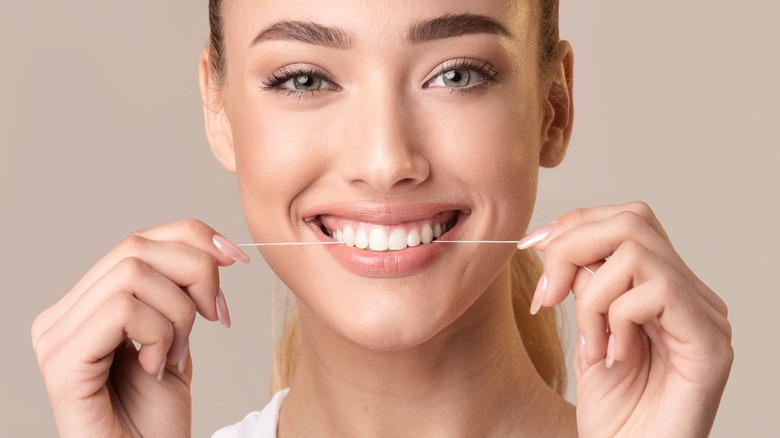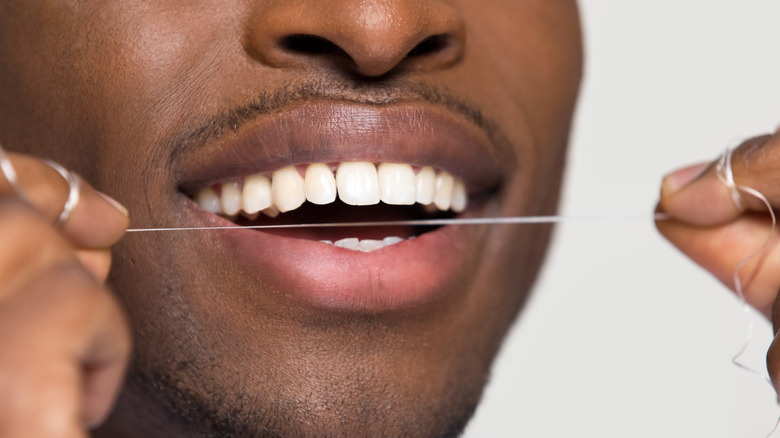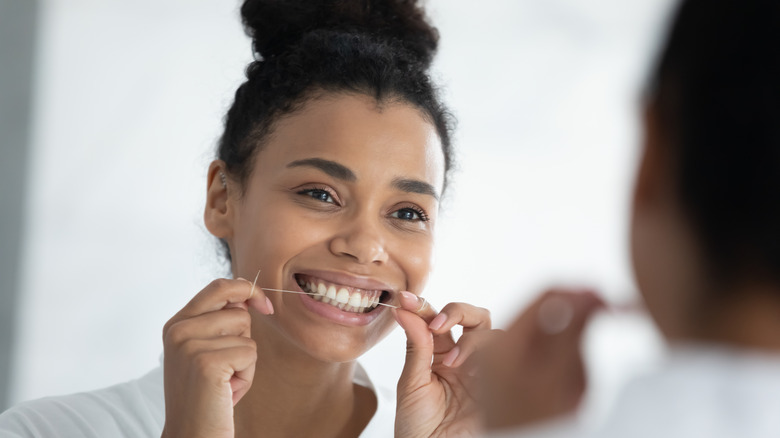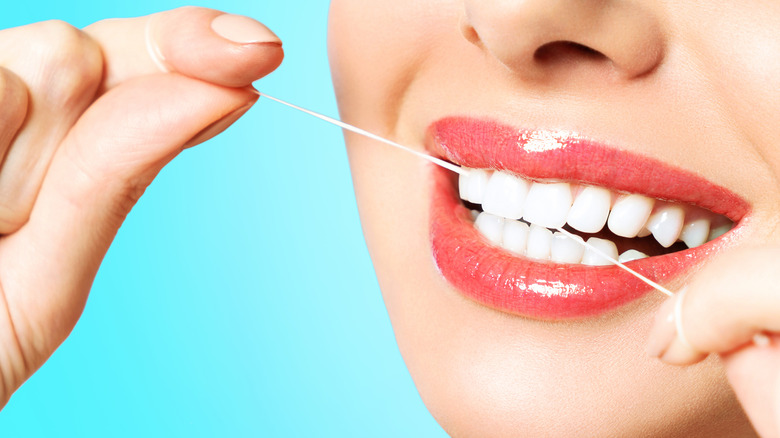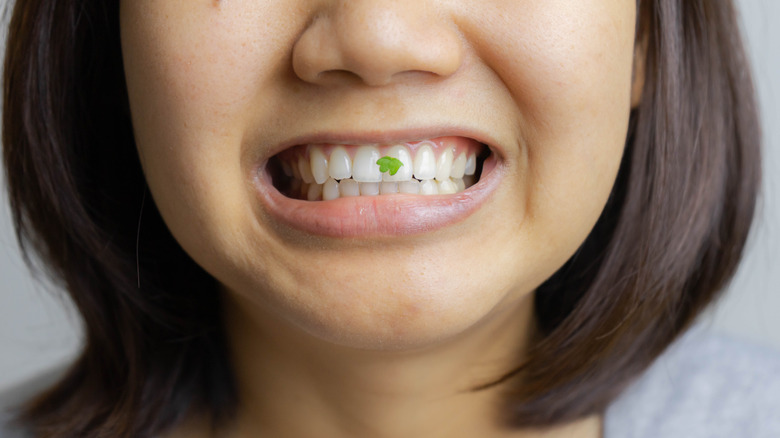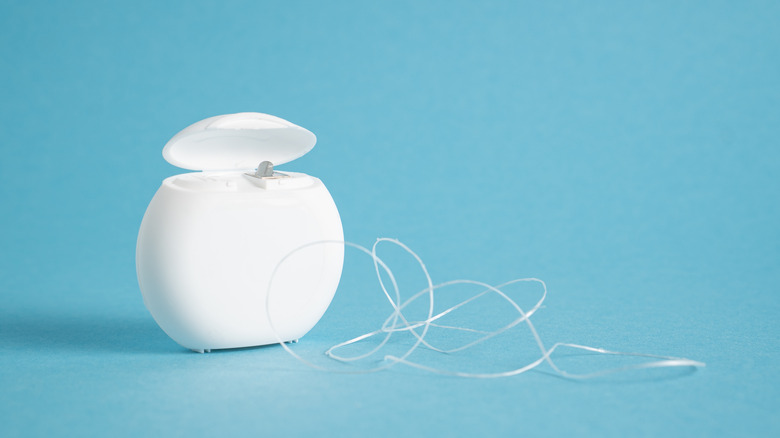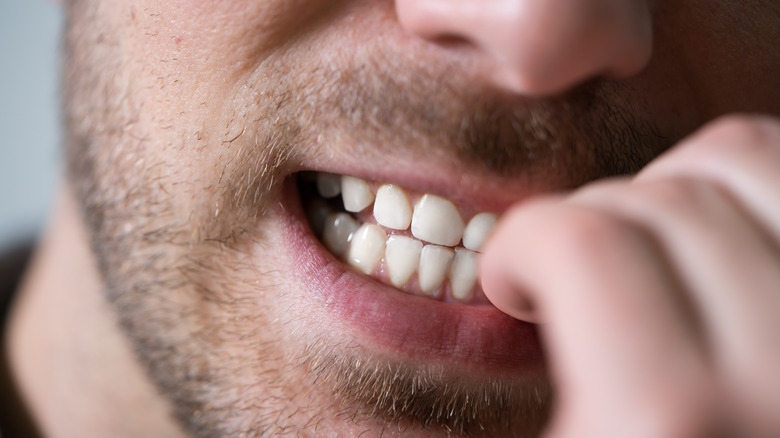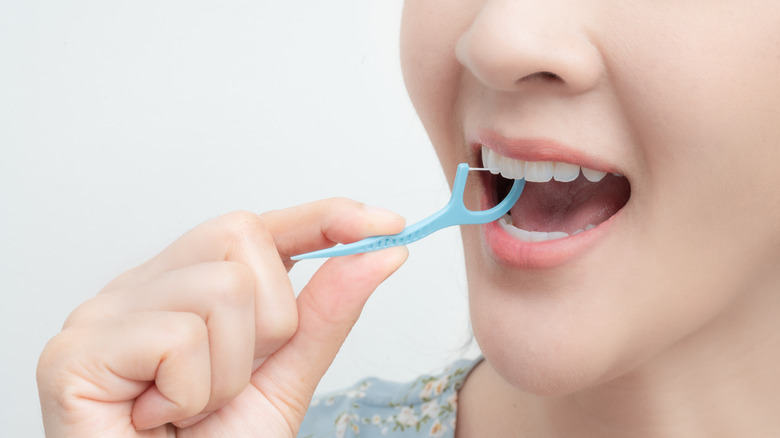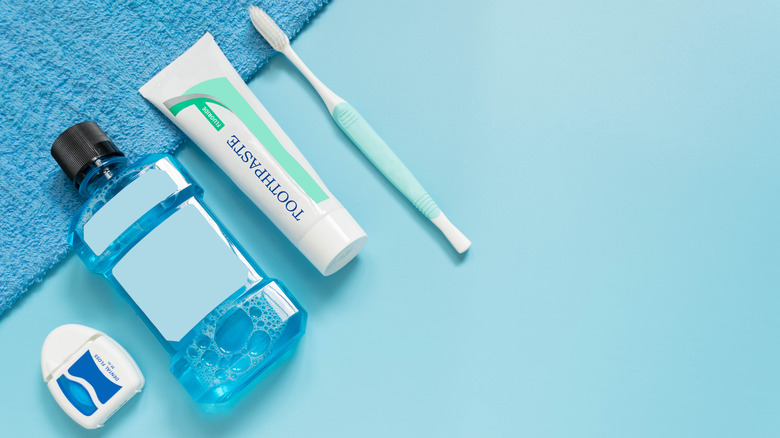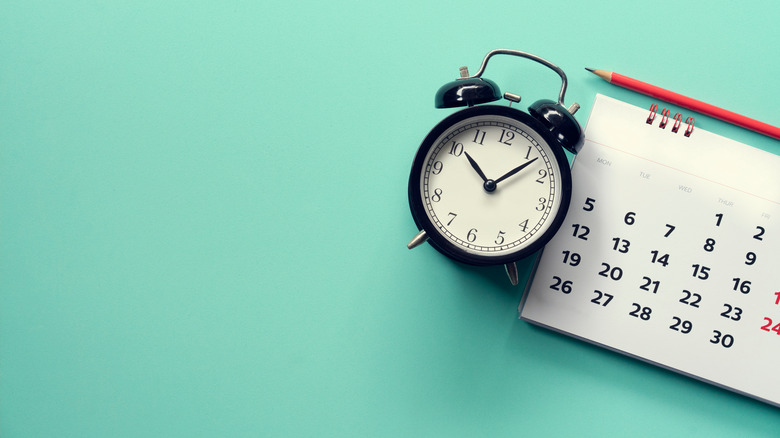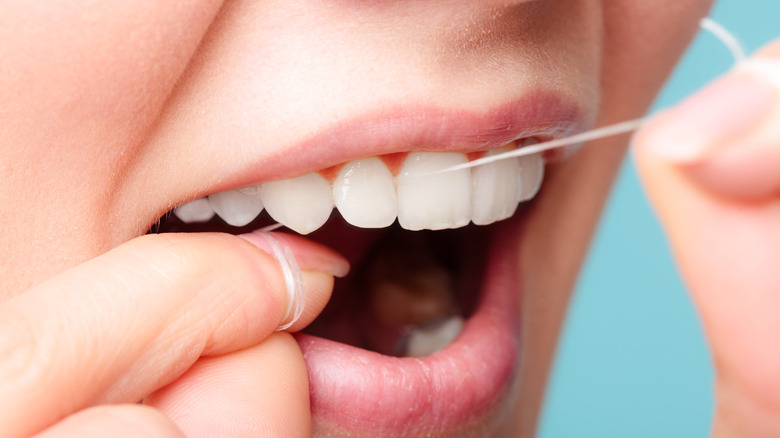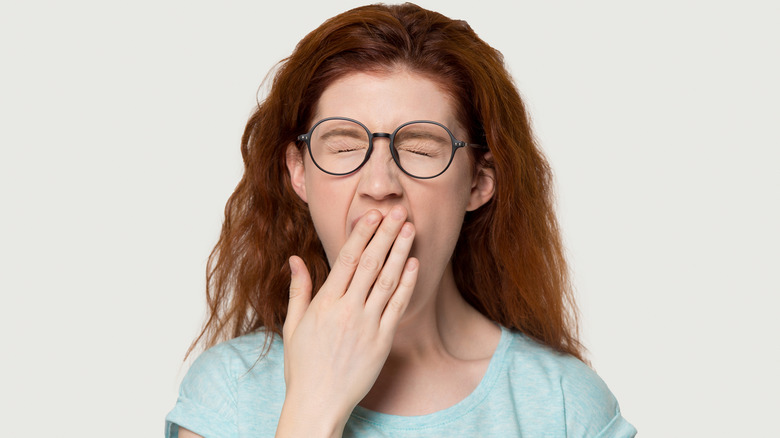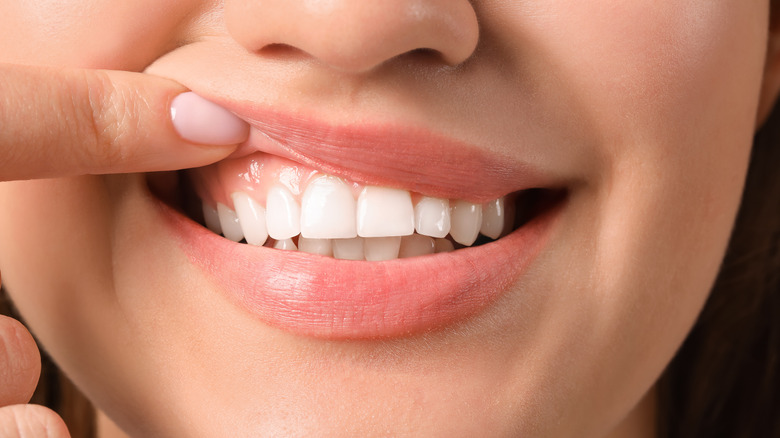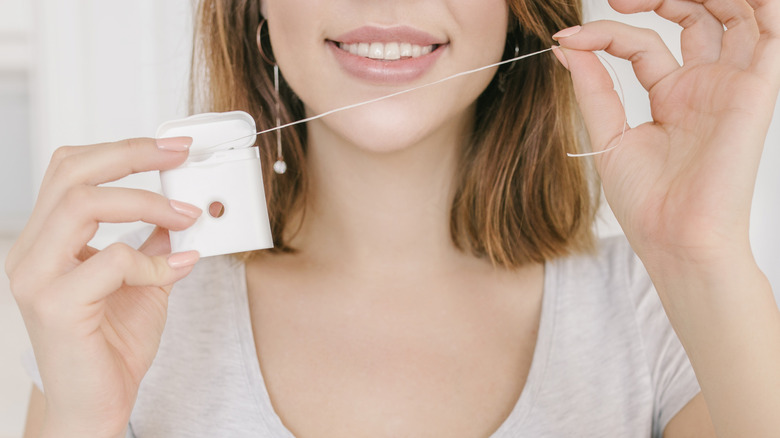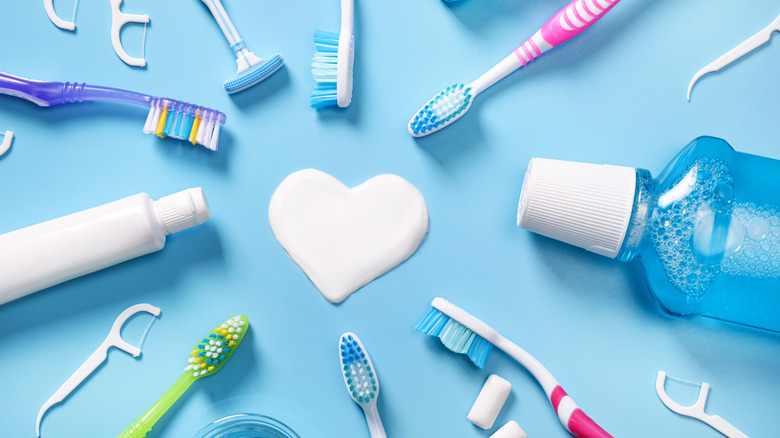Mistakes Everyone Makes When Flossing Their Teeth
How good are you at flossing? And we're not talking about the dance craze here (though, we're pretty good at that, too). Flossing your teeth is an essential part of any dental routine but, surprisingly, many people neglect it. According to a survey undertaken for Waterpik with advice from the American Dental Association, only 16% of people floss at least once per day, with almost half of people who took part in the survey admitting that they've told their dentist that they floss more than they do. Of the people surveyed who didn't floss daily, 55% of them said that it's because it simply takes too long.
Yet, while flossing takes a little extra time during your dental routine, it's an essential part that shouldn't be avoided. "You wouldn't wash only one side of a dirty dish and then put it back in the cupboard to use again tomorrow, would you?" says gum specialist Dr. Reena Wadia to Huffington Post. Flossing correctly can help you make sure that you're getting the most from your dental hygiene routine. Let's take a look at some common mistakes everyone makes when flossing their teeth.
Making your gums bleed
It's pretty logical to want to stop if you see blood while flossing. Blood = bad sign, right? Well, when it comes to your gums, the blood might be a sign that you actually should be flossing more. "Patients tell me all the time that they don't floss because their gums bleed when they do. I tell them to floss more instead," says Dr. Irina Sinensky, a dentist with New York City's Dental House, to NBC News. "Unhealthy gums — usually caused by bad oral hygiene — will bleed easily when they are touched. It's like having a splinter under your skin that you never remove. The body will try to rectify the situation by bringing blood to the area and try to get rid of the infection."
While Sinensky's advice is definitely true, it's also worth pointing out that bleeding gums can be caused by rough flossing or incorrect technique, according to Colgate. Additionally, if you notice blood while flossing on a regular basis, or if the blood is concerning, make sure you book a visit to your dentist to discuss potential causes and solutions.
Flossing too heavily
We all want our teeth to be their best, and sometimes this can lead us to clean them a little too well. In the case of flossing, going too hard on it can be tempting for many people in order to remove the plaque that builds up between and around our teeth, says Milner Dentistry. Doing this, however, can cause damage to your gums and possible bleeding, as well as potentially causing other dental issues.
Instead, Milner Dentistry suggests taking your time with flossing, and going gently. Once you've secured the floss in your fingers, gently guide it between your teeth with a light rubbing movement, avoiding snapping it onto your gums, as Mouth Healthy (from the ADA) states. Once it reaches your gum line, guide it into the space between your gum and your tooth, very gently, making a "C' shape with the floss against the tooth. Then, guide the floss up and down the tooth, rubbing gently against the side of it. Repeat this for each tooth for a perfect, plaque-free smile.
Flossing too frequently
Like all things in life, moderation is key. If you floss too frequently, you can risk overworking your gums, according to Stamford Periodontics & Implant Dentistry Center. This can not only lead to damaging the tissue around your gums, but can also cause and lengthen gum sensitivity. Flossing too often over time can even destroy the gum line, states doctor of dental surgery Dr. Jesus Medina Jr. When this happens, your teeth's roots can become more exposed, which can lead to cavities and decay.
As Medina Jr. states, it takes the bacterial colonies that result in plaque on your teeth around 24 hours to form completely. So, flossing too often is largely pointless, as there won't be anything noteworthy to remove. Also, when you floss, remember not to be too forceful with your cleaning motions on your teeth. Too vigorous a motion over a length of time can wear away the enamel on your teeth, according to Medina Jr., and, in the most profound cases, can result in periodontal bone loss, leading to tooth loosening and loss.
Skipping the flossing when there's no food in your teeth
If you've been eating nothing but soft foods, and avoiding classic things that get stuck in your teeth like popcorn or meat, you might be wondering if there's even any point in flossing. This is a common misconception about flossing your teeth that a lot of people fall victim to, states Modern Dental Hygiene. However, it's vital to remember that removing bits of food is not the sole aim of a flossing routine: the primary point of flossing every day is to remove plaque build-up between the teeth, to help maintain good oral hygiene.
There are obviously times, however, where removing those pesky food particles is necessary, and flossing is ideal for that. If flossing regularly isn't enough to remove particularly stubborn bits of food, Legacy Dental has a top tip (a 'health hack', if you will): take a regular piece of floss and tie a knot in it, and then gently pull the knot between your teeth. The extra girth that the knot adds to the floss will help to dislodge the item stuck in your teeth with a little more force.
Using the same piece of floss for multiple teeth
We live in a society that places an increasing emphasis on reuse. While that's normally a great thing, there are certain items that you really shouldn't reuse — floss being one of them. The purpose of flossing is to remove plaque from between teeth and below the gum line and, in doing so, the floss you use picks up some of that bacteria, advises doctor of dental surgery Lynne A. March, for Dr. March Dentistry. So, if you use the same section of floss that you just used to clean out the plaque in another part of your mouth, you're spreading the bacteria around that you've just dislodged, instead of removing it entirely.
Instead, make sure you use a new section of floss for each tooth gap. That way, you'll be dislodging the plaque without moving it to another location or pushing it back between other teeth, says March. Don't skimp on the amount of floss you need, either: for one flossing session, you'll need around 18 inches, according to the American Dental Association. Wind the length around your finger and slowly unwind it, moving from section to section, while you work through your teeth.
Using objects that aren't designed for flossing teeth
We've all been there: sitting at our desk post-lunch, and we suddenly feel a food fragment in between one of our teeth. No floss at hand, but our fingernails are available. That'll do the trick, right?
This thought process is common, and the amount of objects that have been used by Americans to remove bits of food stuck in our teeth is pretty wild. According to a survey undertaken for Waterpik with consultation from the ADA of just over 1,000 adults, 61% stated they've used their fingernails to remove food from their teeth, while 40% used cards or folded paper. The objects get weirder as the survey continued, with 21% of people using cutlery, 14% using safety pins (no thanks), and 7% using hair. Yep. Hair.
Instead, "It's really easy to use clean and safe items on-the-go and at home — like string floss, dental picks and water flossers," states Dr. Brittany Seymour, assistant professor at Harvard School of Dental Medicine, and ADA spokesperson. "If you're not sure, start by looking for products with the ADA Seal of Acceptance. That way, you know it's safe for your teeth and will get the job done, removing germs rather than introducing them."
Only using floss picks
Trying to navigate yards of dental floss just to get your teeth clean can be frustrating. That's why a floss pick could seem like the ultimate solution, and a simple way to get your teeth looking better than ever. Only using a floss pick, however, is something that way too many people do; and, what's more, it's all too easy to use them wrong.
"Most people don't even use the picks to their fullest potential [and instead] 'pop' them through the contacts and move on to the next space," states Dr. Irina Sinensky, of Dental House in NYC, to NBC News. This, unfortunately, is not a thorough enough clean for your teeth, with Sinensky advising that "It's the up-and-down cleaning motion of each root surface that is recommended" to properly dislodge plaque and give your teeth the attention they need. In addition to this, simply popping floss picks in and out can also spread bacteria from one location to another, particularly if you're using the same pick for multiple teeth. To avoid this, make sure you're using regular floss in your flossing routine, and use a fresh piece for each tooth.
Not flossing before you brush
Considering flossing to be something you do after brushing your teeth is a common mistake, and the opposite of what you should be doing. First off, flossing before brushing makes the whole purpose of flossing (to get rid of plaque) more effective, according to Boston University dentistry professor Jyoti Sonkar, MSD (via Insider). "I prefer to suggest flossing first because doing so loosens up plaque and deposits in between the teeth that you can then brush away," Sonkar states.
Flossing before brushing also increases the efficacy of the fluoride in your toothpaste, which is only able to work properly on your teeth to strengthen them if it comes into direct contact with the tooth itself. By removing plaque with dental floss before brushing, you give the substance more surface area to work with. There's not only a correct time to floss in your tooth-cleaning routine, but there's also an ideal time to do it in your day: for the best results, floss before bed, says Magnolia Dental. This is due to saliva production reducing in sleep, meaning your teeth are less protected. Flossing and brushing with a toothpaste containing fluoride before you go to sleep, therefore, means your teeth stay safe from bacteria overnight.
Neglecting to floss every day
It's very easy to floss "on a whim" and just do it now and again (or, if you're like us, when you remember to do it). Unfortunately, this doesn't quite cut it for dentists. "Even though there has been conflicting evidence about flossing and its effectiveness, I still thoroughly recommend flossing once a day," states Dr. Iain Hoeltschi, a specialist orthodontist and British Dental Association member, to Huffington Post. Hoeltschi points out that regular flossing can lead to healthier gums, and flossing each day effectively removes and minimizes plaque on and between your teeth. Simply flossing when you remember to isn't the route to sustained dental hygiene.
Additionally, it's important to keep your dental routine varied and thorough. "I also recommend using interdental brushes as these are better equipped to remove food particles and bacteria that can build up between teeth," states Hoeltschi. Interdental brushes or electronic flossers can also be a great solution for those who find regular flossing difficult, such as people with arthritis or who have limited dexterity, says fellow British Dental Association member Dr. Rhona Eskander.
Skipping your back teeth
Sounds pretty obvious, right? Well, with 32 teeth in the average adult mouth, getting between every tooth is easier said than done, and missing out or not reaching certain teeth means an inconsistent routine that could cost you your tooth health. Of particular importance are the teeth at the way back of your mouth, says Dr. March, for Dr. March Dentistry. These teeth can be easily forgotten about as they don't have teeth next to them, but they still need attention, particularly as they sit next to the gums at the back of your mouth.
Furthermore, being especially thorough with the back teeth in your mouth is important as these teeth contain ridges that are specially designed to help break down food, meaning that food is more likely to become stuck in them, according to Oral-B. The more food that gets stuck in the teeth, the more chance it has to be converted into plaque by bacteria in your mouth, so paying special attention to the teeth in those hard-to-reach places through flossing and regular brushing is essential.
Flossing without paying attention
It's probably no secret that flossing isn't the most exciting part of anyone's day. And with any routine, it can be easy to switch off while you're doing it. This is a common and easy mistake that you should try to avoid, according to Modern Dental Hygiene. Not only can aimless flossing lead you to neglect teeth and not give them the due attention they need to maintain their good health, but attentive flossing can also reveal to you any other issues you might have with dental hygiene which could need addressing.
But, what if you're struggling to get into a flossing routine in the first place? It can be hard to establish a flossing habit, and that's why simple things like creating a visual cue to remind yourself to bust out the floss is a great place to start, suggests doctor of dental surgery Mark Burhenne, on Ask The Dentist. Making it simple for yourself by keeping multiple packs of floss around your most-visited areas — your desk at work, in your car, in your gym bag — is another great way to prompt you into flossing, particularly if you forgot to the night before.
Flossing too hard
Yes, a huge part of flossing is to maintain gum health, but that's no reason to go overboard. A common occurrence when it comes to a flossing routine is to really attack the gums with floss, rubbing against them too forcefully, or by snapping the floss against them, says Magnolia Dental. When this happens, the gums can become irritated, inflamed, or even bleed — the very opposite of what you want your flossing to achieve.
That's why developing a good technique for flossing is essential for your gums to stay healthy. Move the floss gently between your teeth, going up and down slowly, says Colgate. Apply the same level of gentle pressure when you floss towards the base of your teeth and your gums to remove any food stuck under them without applying too much pressure. Try to avoid any abrupt movements towards the gums, or pushing or snapping the floss against them with too much pressure. This can cause the gums to become torn or bruised.
Rushing when flossing
Hey, we get it: flossing isn't exactly a quick job sometimes, and it's easy to just want it over and done with. Rushing through a flossing routine, however, is something that a lot of people do that they really shouldn't, says Modern Dental Hygiene. Getting around each tooth thoroughly takes time, and it shouldn't be a quick job; if it is, you might not be doing it rigorously enough and missing parts of your mouth, thereby giving plaque even more chance to build up.
Bear in mind, though, that in the grand scheme of things flossing doesn't even take that long. In all, flossing should only take a couple of minutes to do, according to Modern Dental Hygiene. The more time you take, though, the more thorough you'll be and, if you have additional dental considerations like braces, it could take longer, states Healthline. Give yourself 10 to 15 minutes to make sure you can work around everything and get into places that might be hard to reach. It's a small amount of time to take for a huge amount of benefit to your dental health.
Using the wrong floss
For such a simple process, there are a surprising amount of things to consider when choosing a floss that most people just don't factor in. There are many different types of dental floss, and spending time researching the best floss for your needs could optimize the benefits you reap, say Mark and Gina Covington, the husband-and-wife team and members of the Academy of General Dentistry that runs Covington Dental in Hickory, North Carolina.
But choosing between waxed floss, dental tape, disposable flossers or an electric flosser can be a bit confusing, which is why Oral-B has some tips to get you started. If you have smaller gaps between your teeth, a waxed floss might be easier to maneuver into them, whereas those with larger gaps might benefit from dental tape. Spongier floss is a great idea for people who have bridges or braces, whereas disposable flossers or electric flossers might be better for people who want less mess or waste. It all comes down to trial and error, though, and keeping a varied dental hygiene routine is a great way to go. There's no need to limit yourself to just one product!

